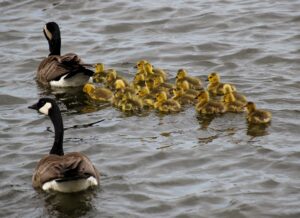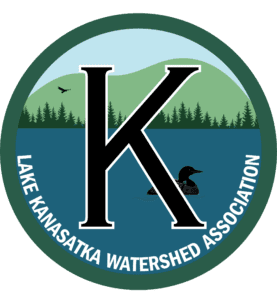
Branta Canadians aka The Canada goose are back on Lake K. The magnificent migrator has become a residential pest.
For two years in a row, Lake has had over 30 geese on Lake K. It is now April 1 they are returning. Jay Rizzo a neighbor of mine on Coe Point Road says that Geese may be hunted beginning October 1. He is also trying to get a special permit permitting hunting more often under the special nuisance hunting license.
The Canada geese are recent arrivals to our lake, but we have quickly learned why Geese and Lake K’s health are not compatible. A hungry goose can consume up to 4 pounds of grass each day, This leads to the elimination of 2 pounds of poop per goose as much as every 12 minutes daily. This poop is dangerous to the lake and its human and animal inhabitants. It contains Nitrogen and Phosphorus that feed the Cyanobacteria and bacteria such as e-coli and listeria that are dangerous to humans and animals.
For two years in a row, I have counted in my small cove off Coe Point Road 36 geese, which included 3 sets of parents and about 24 goslings. You can do the math as to how much poop is being eliminated into Lake K by those numbers.
The Geese chose Lake K because they saw the welcome mat from the ski— large swashes of lush green grass their favorite food.
Now is the time for all to become good Stewards of our Lake, take back the Welcome mat, and make Lake K undesirable to Geese.
Nh Lakes lists the following to aid Stewards in making our lake undesirable to Geese
• Discontinue feeding. Wild birds can find their food.
• Modify landscaping. Allow grass to grow longer. Along with water edges, leave native vegetation, or replant areas with less attractive vegetation such as pachysandra and periwinkle.
• Install barriers along the shoreline. Barriers such as fences and hedgerows have been known to work.
• Use scaring devices and move them around the property periodically. Try large helium-filled balloons, strobe lights, scarecrows with moveable parts, and Mylar flags.
- Utilize dogs. Most effective are free-ranging dogs trained to chase birds as soon as they land.
- Hunting may help. For information on the Canada Geese hunting season in New Hampshire, visit https://wildlife.state.nh.us/hunting/waterfowl-season.html.
- Prevent nesting by manipulating the nests. Since waterfowl are protected by law, a property owner must first register with the US Fish and Wildlife Service at https://epermits.fws.gov/eRCGR/geSI.aspx.
- Obtain a depredation permit. A Federal Migratory Bird Depredation Permit is required to capture or kill migratory birds for depredation control purposes. After applying some of the listed techniques above over an extended period with little to no success, a depredation permit can be requested. Landowners should apply for a depredation permit only after they have involved their local community in the decision process. If a permit is issued, landowners are expected to continue to integrate non-lethal techniques when implementing any lethal measures. Since capture and removal will result in reduced population size, other management methods should become more effective in the future. For more information contact 1-866-4USDAWS (1-866-487-3297).
Article submitted by Jane Nash LKWA Vice President
